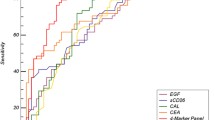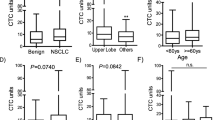Abstract
The aim of this study was to assess the diagnostic yield of the tumour markers carcinoembryonic antigen, carbohydrate antigen 15-3, carbohydrate antigen 19-9 and carbohydrate antigen 125, in serum and bronchoalveolar lavage fluid in a group of patients with bronchogenic carcinoma. Serum and bronchoalveolar lavage fluid samples were collected in a group of 90 patients with benign or malignant pulmonary diseases. After appropriate processing, tumour markers were determined by enzyme immunoassay. The diagnostic yields (sensitivity, specificity and predictive values) in each environment (serum and bronchoalveolar lavage fluid) were obtained by using "Receivers operating characteristic" curve. Determined individually, carcinoembryonic antigen, carbohydrate antigen 19-9 and carbohydrate antigen 125, showed the greatest diagnostic accuracy in bronchoalveolar lavage fluid. Carbohydrate antigen 15-3 did so in serum. Carcinoembryonic antigen was the most relevant marker in bronchoalveolar lavage fluid. For the factors evaluated in this study, determination of carcinoembryonic antigen, carbohydrate antigen 19-9 and carbohydrate antigen 125 in bronchoalveolar lavage fluid were clinically more useful markers in comparison with serum, although the latter may also be helpful in certain situations. Although there is no specific tumour marker for lung cancer, the combination of several can be used to diagnose most patients with lung cancer and also to rule out false positive and negative cases.


Similar content being viewed by others
References
John DM, Joan H. Neoplasms of the lung. In: Fauci AS, Braunwald E, Kasper DL, Hanser SL, Longo DL, Jameson JL, et al., editors. Harrison’s principles of internal medicine, vol. 2. New York: McGraw Hill; 2008. p. 2275–304.
Henschke CI, McCauley DI, Yankelevitz DF, Naidich DP, McGuinness G, Miettinen OS, et al. Early lung cancer action project: overall design and findings from baseline screening. Lancet. 1999;354:99–105.
Kobayashi T, Xu XW, MacMahon H, Metz CE, Doi K. Effect of a computer-aided diagnosis scheme on radiologists’ performance in detection of lung nodules on radiographs. Radiology. 1996;199:843–8.
Kido S, Ikezoe J, Naito H, Arisawa J, Tamura S, Kozuka T, et al. Clinical evaluation of pulmonary nodules with single-exposure dual-energy subtraction chest radiography with an iterative noise-reduction algorithm. Radiology. 1995;194:407–12.
MacMahon H, Engelmann R, Behlen FM, Hoffmann KR, Ishida T, Roe C, et al. Computer-aided diagnosis of pulmonary nodules: results of a large-scale observer test. Radiology. 1999;213:723–6.
Lam S, Shibuya H. Early diagnosis of lung cancer. Clin Chest Med. 1999;20:53–61.
Sidransky D, Tokino T, Frost P, Hamilton S, Levin B, Vogestein B. Identification of ras oncogene mutations in the stool of patients with curable colorectal tumors. Science. 1992;256:102–5.
Sidransky D, Von Eschenbach A, Tsai YC. Identification of p53 gene mutations in bladder cancers and urine samples. Science. 1991;252:706–9.
Sung HJ, Cho JY. Biomarkers for the lung cancer diagnosis and their advances in proteomics. BMB Rep. 2008;41:615–25.
Andrews CO, Gora ML. Pleural effusions: pathophysiology and management. Ann Pharmacother. 1994;28:894–903.
Xiao T, Ying W, Li L, Hu Z, Ma Y, Jiao L, et al. An approach to studying lung cancer-related proteins in human blood. Mol Cell Proteomics. 2005;4:1480–6.
Chen Y, Zhang H, Xu A, Li N, Liu J, Liu C, et al. Elevation of serum l-lactate dehydrogenase B correlated with the clinical stage of lung cancer. Lung Cancer. 2006;54:95–102.
Daniel WC, Stewart S. Tumour markers. In: Burtis CA, Ashwood ER, editors. Teitz textbook of clinical chemistry 3rd edn. Philadelphia: Saunders Elsevier; 1999. p. 733–7.
Shitrit D, Zingerman B, Shitrit AB, Shlomi D, Kramer MR. Diagnostic value of CYFRA 21-1, CEA, CA 19-9, CA 15-3, and CA 125 assays in pleural effusions: analysis of 116 cases and review of the literature. Oncologist. 2005;10:501–7.
Pasaoglu G, Zamani A, Can G, Imecik O. Diagnostic value of CEA, CA-19-9, CA 125 and CA 15-3 levels in malignant pleural fluids. Eur J Gen Med. 2007;4(4):165–71.
Pardos MC, Alvarez-Sala R, Terreros Caro FJ, Gomez L, de Gomez Terreros FJ, Villamor J. The concentrations of five tumor markers in both BAL fractions in lung cancer patients in relation to cigarette smoking. Tumori. 1999;85(6):454–7.
Fukuda I, Yamakado M, Kiyose H. Influence of smoking on serum carcinoembryonic antigen levels in subjects who underwent multiphasic health testing and services. J Med Syst. 1998;22(2):89–93.
Alexander JC, Silverman NA, Chretien PB. Effect of age and cigarette smoking on carcinoembryonic antigen levels. JAMA. 1976;235(18):1975–9.
Charalabopoulos K, Karakosta A, Bablekos G, Golias C, Charalabopoulos A, Tsanou E, et al. CEA levels in serum and BAL in patients suffering from lung cancer: correlation with individuals presenting benign lung lesions and healthy volunteers. Med Oncol. 2007;24(2):219–25.
Niho S, Shinkai T. Tumor markers in lung cancer. Gan To Kagaku Ryoho. 2001;28(13):2089–93.
Lazarev SM, Massard Zh, Reshetov AV, Nikolaev GV, Volgin GN, Osipov EV, et al. Role of biological tumor markers CEA, Cyfra-21, NSE, TU M2-PK in diagnosis and treatment of lung cancer. Vestn Khir Im I I Grek. 2010;169(1):39–43.
Cedres S, Nunez I, Longo M, Martinez P, Checa E, Torrejon D, Felip E. Serum tumour markers CEA, CYFRA21-1, and CA-125 are associated with worse prognosis in advanced non-small-cell lung cancer (NSCLC). Clin Lung Cancer. 2011;12(3):172–9.
Yang X, Wang D, Yang Z, Qing Y, Zhang Z, Wang G, et al. CEA is an independent prognostic indicator that is associated with reduced survival and liver metastases in SCLC. Cell Biochem Biophys. 2011;59(2):113–9.
Zeynep AS, Ceyda K, Tuncay G, Ozme D, Mutaf I, Bayindir U, et al. Tumor markers in blood and in bronchoalveolar lavage fluid in patients with lung cancer. Turk Respir J. 2005;6(2):73–7.
Dabrowska M, Grubek-Jaworska H, Domagała-Kulawik J, Bartoszewicz Z, Kondracka A, Krenke R, et al. Diagnostic usefulness of selected tumor markers (CA125, CEA, CYFRA 21-1) in bronchoalveolar lavage fluid in patients with non-small cell lung cancer. Pol Arch Med Wewn. 2004;111(6):652–9.
Ando S, Kimura H, Iwai N, Shima M, Ando M, Kuriyama T. Optimal combination of seven markers in prediction of advanced stage at first examination of patients with non-small cell lung cancer. Anticancer Res. 2001;21(4):3085–92.
Pina TC, Zapata IT, Hernandez FC, Lopez JB, Paricio PP, Hernandez PM. Tumour markers in serum, bronchoalveolar lavage and biopsy cytosol in lung carcinoma: what environment lends the optimum diagnostic yield? Clin Chim Acta. 2001;305(1–2):27–34.
Author information
Authors and Affiliations
Corresponding author
Rights and permissions
About this article
Cite this article
Ghosh, I., Bhattacharjee, D., Das, A.K. et al. Diagnostic Role of Tumour Markers CEA, CA15-3, CA19-9 and CA125 in Lung Cancer. Ind J Clin Biochem 28, 24–29 (2013). https://doi.org/10.1007/s12291-012-0257-0
Received:
Accepted:
Published:
Issue Date:
DOI: https://doi.org/10.1007/s12291-012-0257-0




